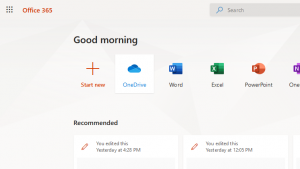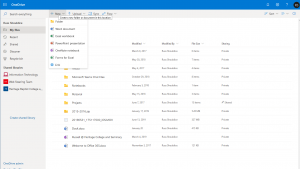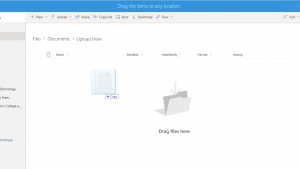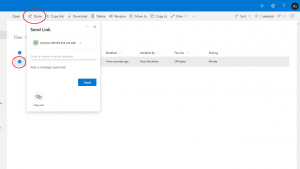First off, what is OneDrive?
OneDrive is a cloud based program, hosted by Microsoft. It is apart of our Office 365 subscription and is therefore easily able to integrate into our workflows.
How to Upload Your Files onto OneDrive for Work at Home
With the current state of health in the world, we all must proceed forward in a manner that allows us to access tools and files and produce work from home. OneDrive is going to be a key component in allowing us to do so. Whether accessing OneDrive from your browser or from an app downloaded on your device, you now have the freedom to transfer and access work files simply over OneDrive. This will grant you access to these files from virtually anywhere and thus alleviate the necessity for coming in to work. This article will cover the two ways of doing that, through the app and/or through your web browser.
How to Access OneDrive in the Cloud
Because OneDrive is cloud-based, files and folders stored there can be accessed from almost any device with a modern web browser. All modern web browsers including Google Chrome, Mozilla Firefox, Microsoft Edge, Apple Safari, and many more can be used to login to and access files stored in OneDrive.
To access OneDrive navigate to http://office.heritagecs.edu and login with your Heritage email address and password. After logging in click on the OneDrive icon in the Good morning section.
(click the image to see a larger version)
Create new files and folders
- To create a folder, click the + New button in the border located at the top of the page. Then click Folder.
- Once you create and name your folder/s you can then upload files onto them from your computer.
- To do this, simply drag and drop a file from your computer onto the main area in the browser. The file will be uploading into that folder.
(click the images to see a larger version)
Share a files and folders
- To share a folder, hover your mouse over it and a translucent circular button will appear to the left, click it and a blue check mark will appear inside.
- From there, direct your attention back up to the border where you previously selected “+ New” you will see a “Share” option in its place. the Sharing menu will pop open.
- Select “anyone with the link can edit” and write down the name of the staff and/or faculty member that you would like to share the contents of that folder with.
- You can send an email directly to the person you’d like to share with by entering their email address and clicking Send.
- Or, you can click the Copy Link button and paste the link into an email, or use it elsewhere.
How to Use the OneDrive App
An alternate way to access the uses of OneDrive is to download the OneDrive app onto your computer. For Windows10 users, it should be on your computer already. If not, you can find the download link for OneDrive by locating the “Get the OneDrive Apps” link by logging in to OneDrive using your browser. Again, the link to OneDrive is http://office.heritagecs.edu
- Once on your computer, open the app and it will ask you for your email. Search for it in the start menu if needed.
- Use your corporate Heritage email address and proceed to login.
- From there, OneDrive will go over the process for you and explain how to use the app. Make note of the location of the OneDrive folder, and some new icons for the status of files.
- OneDrive will sync any files and folders you add into the OneDrive folder on your computer to the cloud. These files and folders will be accessible across all devices because including the app on your phone and in the browser.
- If you wish to share files simply folder the instructions above on sharing files and folders. Alternatively, simply right-click on a file and choose ‘Share’. This will give you a dialog similar to the online version of the sharing menu.




